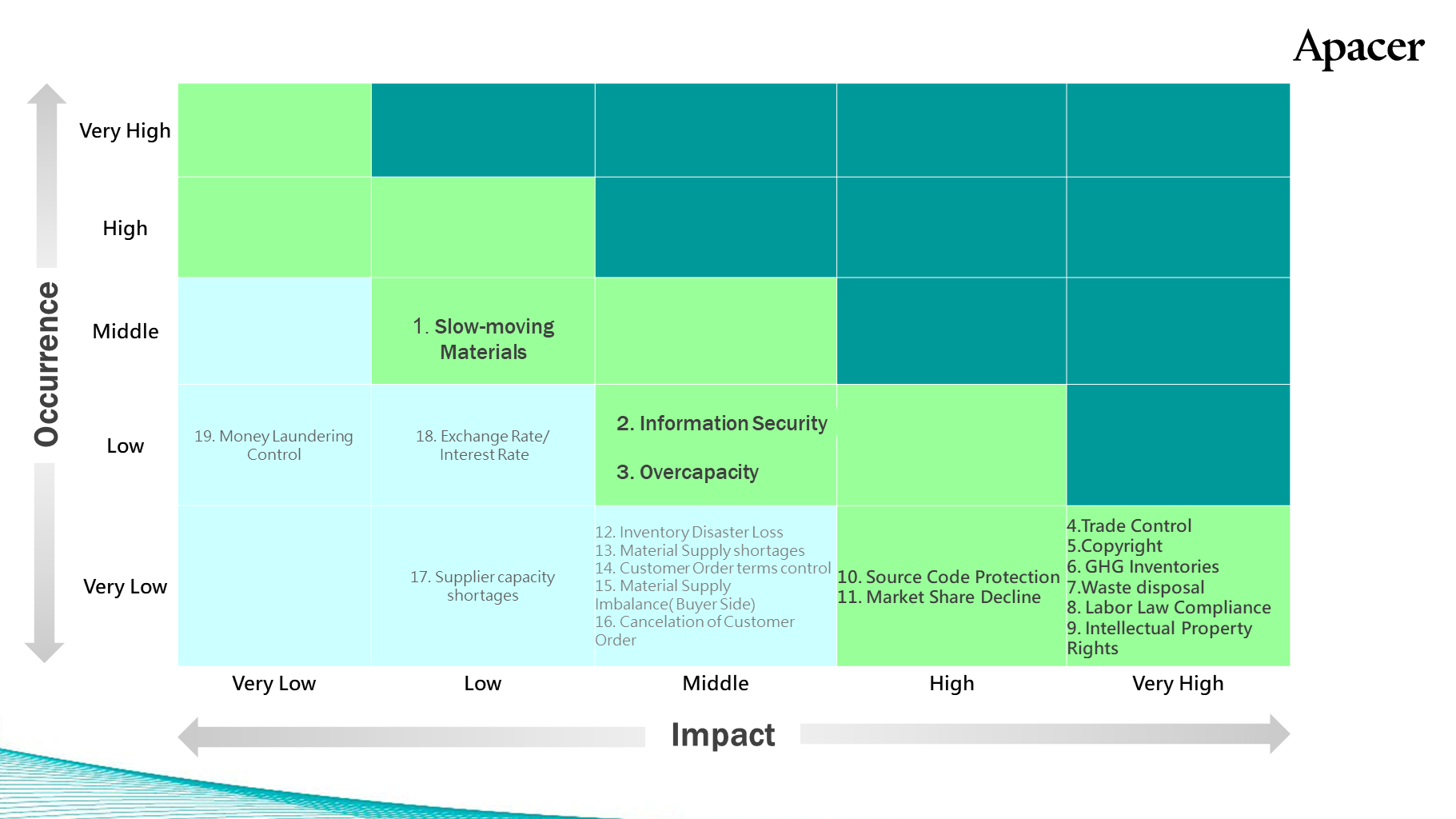|
Organizational Structure and Rights of Risk Management |
|
In order to promote the sound operation of the company and the sustainable development of the company, Apacer Technology has formulated "risk management policies and procedures". When the company is engaged in operating activities, it carefully examines possible internal and external potential risks from the perspective of sustainable business operations, and implements the risk management mechanism. Operation, improve the efficiency of risk management division of labor, in order to reasonably ensure the achievement of the company's strategic goals. |
 |
|
|
Board of Directors |
|
The Board of Directors is the highest decision unit of the company's risk management, which is in charge of approving the risk management policies and related measures, supervising the implementation of the system, and ensuring the effectiveness of the management mechanism. |
|
Sustainable Development Committee |
|
The Sustainable Development Committee of the company is led by the chairman of the Board of Directors. |
|
Risk Management Team |
|
Risk Management Team: |
|
Risk Management Scope |
|
The Company conducts risk management operations based on the following types of risks: |
|
||||||||||||||||||||||||
|
Each member of the risk management team identifies, measures and responds to the risk items seen by the company's internal and external units, and conducts follow-up operations for the identified risk items in response to the actions that need to be improved in order to effectively control the risk within a controllable range. |
|
Operation contents of risk management |
||||||||||||
|
|
Risk Management Execution Status |
|
Apacer actively promotes the implementation of the risk management mechanism, The "Risk Management Policies and Procedures" was established on August 4, 2021 and approved by the board of directors. In October 2021, the original "Corporate Social Responsibility Committee" was adjusted to the "Sustainable Development Committee". In addition to the original ESG implementation team, the "Sustainable Development Committee" added a "Risk Management Team" to be responsible for risk assessment and response and other matters related to operational risk management.
The operation of the risk management team of the company in 2022 is as follows: |
|
Regular meeting held |
|
Quarterly risk management team meetings: The company conducts risk identification, measurement, response and improvement tracking on the company's overall risk on a quarterly basis. High-level executives and members of the risk management team carry out risk identification, measurement, response and improvement tracking on the company's internal operating activities to identify potential risk events that may cause the company's goals to fail to be achieved, cause losses or negative impacts. And based on the company's strategic goals, the views of internal and external stakeholders, the tolerance of risk impact and available resources, select risk response countermeasures or implement risk mitigation plans, and then the members of the risk management team will continue to monitor in conjunction with relevant personnel of each operating unit. Report to the risk management team in a timely manner and make relevant records. The company's risk identification includes but is not limited to operational risks, market risks, environmental safety and health risks, financial risks, human resource risks, information security risks, environmental risks, emerging risks (such as climate change risks, etc.) and other operational-related risks. |
|
Report to the board of directors regularly |
|
The risk management team compiles the risk management implementation situation and evaluation report every quarter, which includes the risk assessment results of each aspect, and after explaining the control and supervision procedures for the higher risk aspects, it is regularly submitted to the sustainable development committee to report risk management result to the board of directors. Last risk management result reported to the Board by the Sustainability Committee was on 14 December 2022. |
|
2022 Corporate Risk Matrix |
|
Based on the principle of materiality and risk classification, the mid and high-level executives and risk management team members identify and measure the internal risks of the company, and compile the risk matrix as follows. |

|
Table: Risk management summary table |
|
||||||||||||||||||||||||||||
